Loading controls for western blots, what a boring topic. I have covered it before, in this article about the Austrian cancer and diabetes researcher Richard Moriggl. There seems to be a schizophrenic discrepancy between what journals expect of their authors, and what these journals are actually prepared to tolerate. The bigger problem however is that too many scientists don’t just ignore, but actively defend the practice of not probing for loading controls for each protein gel. They say a “library” method perfectly suffices, when one separate loading control gel is run once and then used as reference for all future gels with same samples. Loading control libraries became notorious in the research fraud affair around the plant scientist Olivier Voinnet, and even there certain journals can’t be bothered. It is just controls, who cares.
There are many arguments against this sloppy attitude to loading controls, all listed here. One of them: how do you as Principal Investigator want to make sure that the result you ordered was not achieved by some “accidental” mis-loading of the gel? If you asked your team for a Western blot, in order to verify if a protein X is down-regulated after treatment Y, because this is the result you urgently need for the revision of your paper – how do you know the samples were loaded equally, if your loading control comes from a “library”? Certain controls are sometimes better left not done.
It is a very slippery slope attitude, and I will show on the example of Moriggl and other biomedical researchers that it can lead to even bigger problems with data integrity. Some try to solve those by attacking the messenger.
Richard Moriggl: new discoveries
My earlier article covered several instances of papers from Moriggl lab at the Ludwig Boltzmann Institute Cancer Research and Medical University of Vienna in Austria. Two papers were corrected so far.
In the correction of Mueller et al, Diabetes, 2017 the inappropriate loading controls were addressed, which were previously flagged on PubPeer by a reader of my site. It seems Moriggl, or rather his collaborator Jan Tuckermann at University of Ulm in Germany, (where the gels were done, according to my source) was not always able to provide the correct loading controls. Hence the authors simply replaced the figure panels with new data.
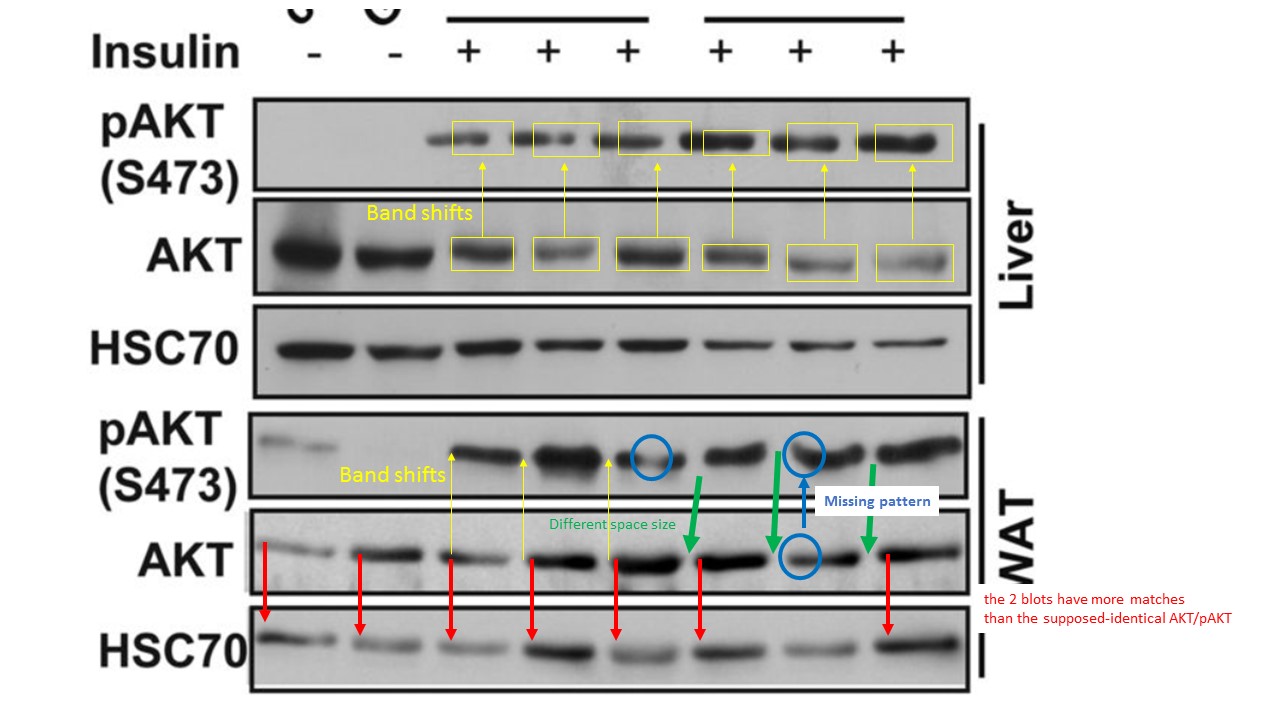
This was the correction notice, issued by American Diabetes Association in February 2018
“In the above-mentioned article, the following errors were detected:
-
In Fig. 2C displaying AKT and phosphorylated AKT (pAKT) expression in epididymal white adipose tissue (eWAT) and liver, the AKT immunoblotting was not the corresponding blot to the pAKT. The authors are replacing this figure with the corresponding total AKT in the liver and providing a blot repeat of the eWAT, where all antibodies were probed on the same membrane. The authors recalculated this blot accordingly with similar findings to that previously published.
-
In Fig. 6E, AKT and pAKT were not shown on the same gel. The authors repeated this Western blot and detected AKT and pAKT on the same immunoblot. The recalculated data are now shown in a revised Fig. 6E.
-
In online Supplementary Fig. 4F, the authors now present the respective loading control, using Actin expression analysis together with that for AKT and pAKT.
The authors apologize for any inconvenience caused to the readers. The online version has been updated to correct these errors.”


Even now the corrected blots do not really match, or are presented improperly. New gels in Figure 6E are hopelessly overexposed, neither blot background nor any baseline trace signal of phosphorylated AKT is visible (AKT-expressing samples without obvious phospho-AKT signal should at least show miniscule trace bands when residual signal is digitally boosted). This blot overexposure practice is not acceptable in 2018 anymore, when the images were submitted for correction. Also the total AKT gel for figure 2C is new, but it doesn’t match the old pS473-AKT blot, which remained. It is not a minor issue, because the first two lanes of that phospho-AKT gel also lack all traces of baseline signal.
But at least there was a correction, which can serve as a warning. Other journals ignored the mismatched loading controls in Moriggl and Tuckermann papers.
The other Moriggl correction was in the journal Cell Death and Disease, published by Nature Publishing Group. The paper Javaheri et al 2016 had some mismatched loading controls, but the Correction, issued in July 2018, only addressed this duplication:
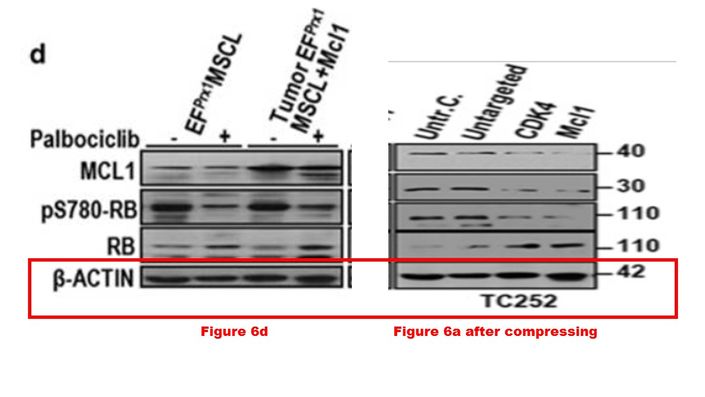
The gels were apparently not just accidentally duplicated, it was shrunk vertically and darkened, possibly to make it look different. This should have given the publisher cause for alarm and prompt Springer Nature to check the rest of the data for integrity. Apparently this didn’t happen.
Two months after the correction, in late September 2018, another reader approached me with a hint about the Supplementary Figure 8 of that same Javaheri et al 2016 paper from Moriggl lab. I looked into that, and this is the problem visualised:
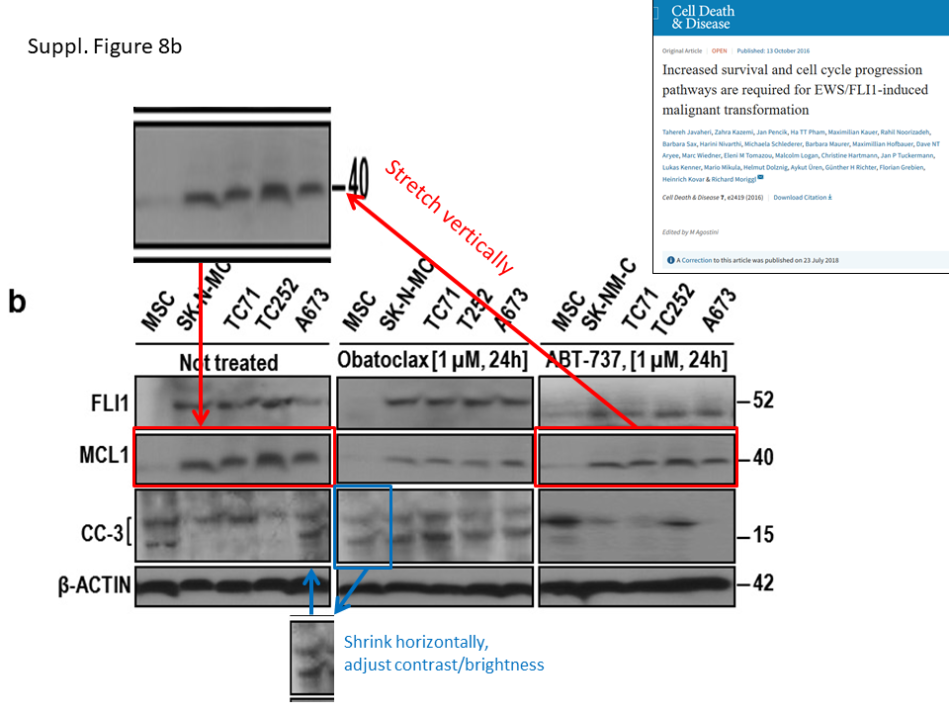
The gel bands look duplicated, after they were stretched, contrasted and put into a different experimental context. I notified the journal Cell Death and Disease about their failed correction. The academic editor Gerry Melino replied to me immediately, where he strengthened the suspicions of duplicated gel bands with his own analysis and announced to have already forwarded the case to the Ethical Committee with Springer Nature. Soon after, Journal Development Manager at BMC and SpringerOpen, Rebecca Pearce, wrote to me thanking for flagging my concerns and announcing an investigation.
Even the responsible Ombudsman of the Vetmeduni Vienna, Mathias Müller, replied to me eventually:
“The responsible (co)authors are informed and are clarifying the situation together with the journal/publisher.
The vice-rectorates of the Vetmeduni and the MedUni Vienna, the executive board of Ludwig Boltzmann Society and the Austrian Agency for Research Integrity are involved and will receive, just like the publisher / the journal. the statement, respectively the report.”
Maybe it is always worth it to take even allegedly minor issues like mismatched loading controls seriously. Who knows what else goes on in such labs.
PubPeer brawl over paper from Korea
More recently, a small issue of duplicated loading controls prompted some PubPeer commenters attack others as ” the “loading control” police”. The 8-year old paper Hwang et al J Urology 2010, was questioned on PubPeer: “Are these all WBs are from the same gel?”

The first author and corresponding author Jung Jin Hwang of University of Ulsan College of Medicine, Seoul, admitted then that they indeed are not:
“These data are acquired from the same samples, although from different gels. It’s a representative blot of tubulin.”
The weird thing was how some PubPeer data integrity experts replied:
“The preferences for loading controls have been debated in various PubPeer forums ad nauseum. Running a separate gel to confirm equal protein content is a common and acceptable practice.” [Leucanella Acutissima]
and
“Yup, once again the “loading control” police going after people who’ve probably done nothing wrong. We’ve been over this time and time again with Hoya, and it still hasn’t sunk in that this practice is generally considered acceptable.
I realize it’s probably tempting to attempt to cut one’s losses when one who has made a hobby out of finding duplications in papers with many gels/blots spends his valuable time on a particular paper without being able to identify one. But I’d urge such Peers to resist this temptation and avoid posting whatever mundane low-hanging-fruit they latched onto in their frustration”. [Lyophyllum Pulvis-horrei]
and
“Exchanging between them [loading controls, LS] is usually made by mistake and has no impact on the scientific results of the research. If one wants to point out concerns, better do it on the results rather than on the loading controls” [Harpochilus Phacocarpus].
It is the downside of PubPeer anonymity which lets people ad hominem attack those posting valid criticisms, or spout unscientific defences of bad scientific practice. Behind anonymity, you don’t have to answer for your arrogant ignorance or your bullying behaviour, or in fact, the quality of your own research. In any case, even this alleged non-issue of loading control libraries was just a hint of what else goes on in that lab. Gel bands were copy-pasted into scans of other gels in a different paper by same author, Hwang et al Invest New Drugs 2012:
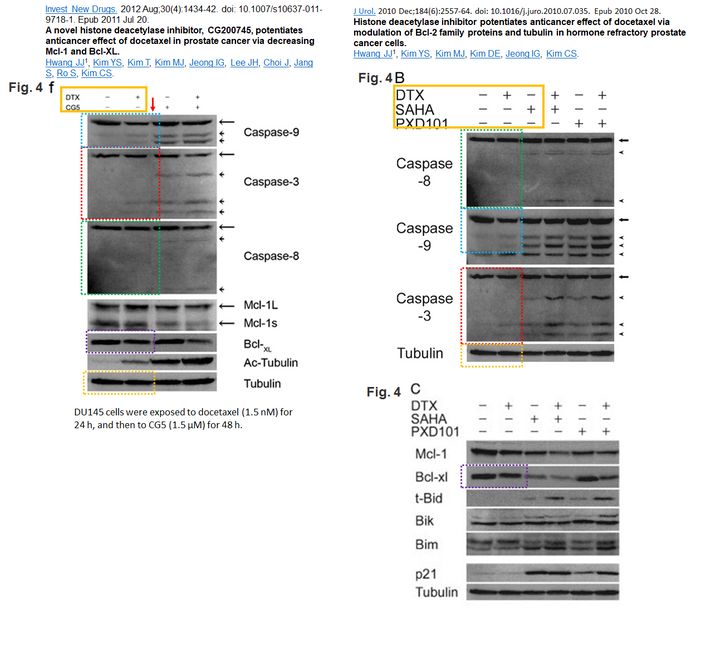
That is actual intentional image data manipulation in Photoshop, a clear form of research misconduct by whoever did it. But then again, head biologist of French CNRS, Catherine Jessus, was acquitted in full for exactly same, the Sorbonne University investigation declared earlier this year such gel band copy-pasting to be good scientific practice.
BethAnn McLaughlin, victim of my harassment?
In late October 2018, when I raised on Twitter the issue of PubPeer evidence in some papers from the BethAnn McLaughlin lab at Vanderbilt University in Nashville, Tennessee, and how she replied to that, I faced the wrath of an indignated kangaroo court Twitter community. McLaughlin does certainly a very important job of raising awareness to the issues of sexual harassment in academia. Yet to me it was not clear why she dismissed the objectively real problems flagged in her papers as vengeful false accusations from accused harassers. Myself, I was described at best as a misogynist bully who conspires with sexual harassers to damage McLaughlin’s cause, a willing enabler of abuse of women in STEM, and at worst: I will never find out, but there were hints. The debate of whether loading controls should be run on the same gels or not, was led on Twitter with the background of whether I am a practising abuser of women myself.
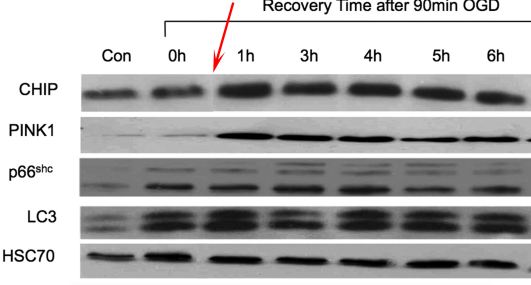
That was the story, which starts with the spliced gel shown above. After initial concerns were raised about it in Palubinsky et al Antioxid Redox Signal 2015, McLaughlin immediately posted this peculiarly-worded reply:
“Sadly, the person who is retaliating against me for reporting him for threatening to ‘destroy’ a student is bringing this forward into bullying my students as well. This is not what PeerPub is for. I suggest you read my blog on the hell this person put me thru here. Also, if you persist in harassing my students, I will go public with who you are.
https://tenureshewrote.wordpress.com/2015/09/21/title-ix-a-step-by-step-guide/”
The first author, a former student of McLaughlin’s, uploaded original gel scans shortly after I raised on Twitter the issue with her advisor’s strange reply. It turned out, the splicing was indeed a minor issue, serving to remove the molecular weight ladder. PubPeer’s loading control integrity judge Leucanella Acutissima declared “Case closed”. But the two gel images, if one looks at the shapes of the bands and other hints, were unlikely part of the same gel. It seems, loading control libraries are apparently not an uncommon thing in the McLaughlin lab.
Even if one ignores differently shaped bands and agrees that HSC70 and CHIP blots are two parts of same gel (and the pressure on Twitter was rather huge), what about the other panels, those for PINK, p66, LC3? Palubinsky herself said in a tweet that the other gels were “run with same samples”, “after verifying proper loading”. Which means, a loading control library was used. This may be OK for McLaughlin and her scientific followers, but there are other practices which look even less acceptable. Like these reused western blot bands, in Musiek et al J Biol Chem 2008 and Brooks et al J Neurochemistry 2011:
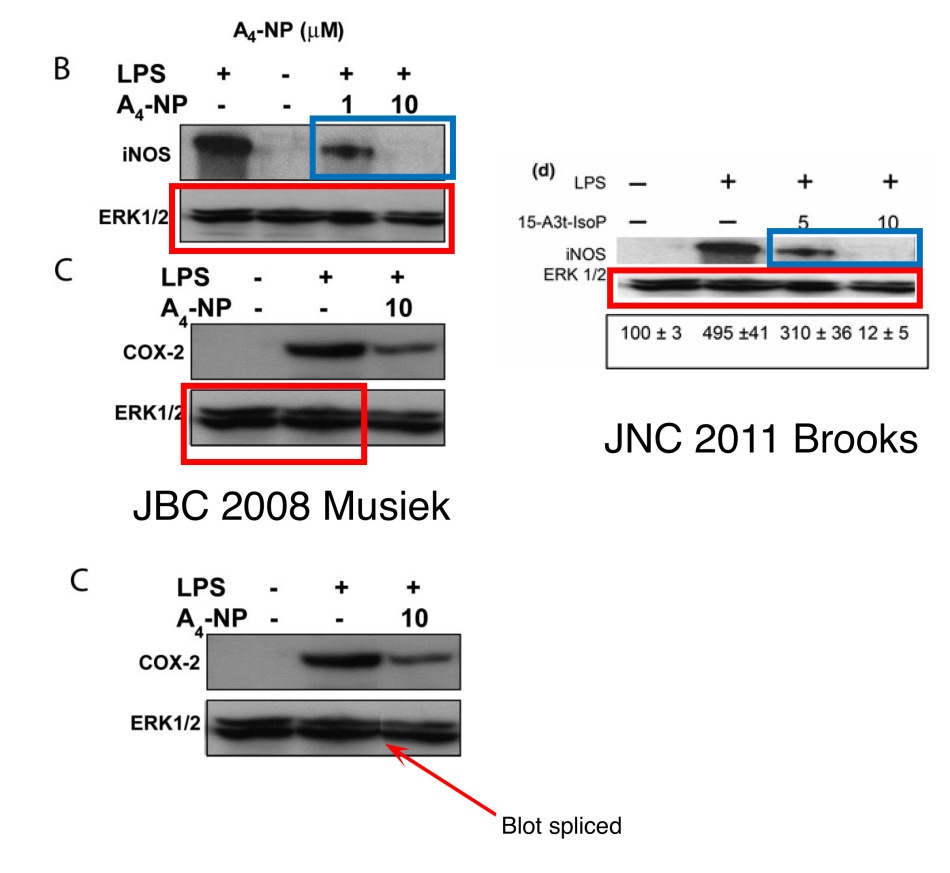
Some of those are loading controls (ERK1/2), irrelevant according to some PubPeer experts, but they were reused trice, in two different papers, each time for different experimental conditions. Also the iNOS blot was reused improperly, to stand in for different samples. McLaughlin addressed the evidence of inappropriately assembled figures in her lab’s papers head on with this:
“I am in the middle of a Title IX complaint with a faculty member who is being investigated for retaliation and harassment. He has clearly crossed a line and is now attempting to defame my student’s work. I stand by these studies”.
It is not clear whom she accuses of having duplicated those gel bands. The first author Erik Musiek was much more helpful in his PubPeer contribution:
“The A4-NP and A3-IsoP blots in the 2009 and 2011 paper are from the same experiment and are taken from the same membrane. The strip/reblot did not always come out well, so I ran all the samples in the same order on another gel in parallel and blotted for ERK, used this as the loading control for all of the other blots (in retrospect not the best practice, but hardly fabrication)”.
The “loading control library” seems now as normal practice in McLaughlin lab, though I am sure Twitter experts will disagree and discuss again my ulterior motives and sexual harassment records. Another PubPeer commenter thanked Musiek and pointed out:
“You state that the loading controls are duplicated in the JBC paper because they are for the same samples, but this does not appear to be correct according to the labelling of the blots. In panel B above the first ERK lane is the control for the LPS treated sample. However, in panel C the identical band is shown as the control for the non-LPS treated sample.
Regarding the image duplication of data between the JBC and the JNC paper, this was not done by you, but by a colleague to whom you sent the data. However, notice that the incorrect lanes were used. According to the original data that you have posted (I commend you for maintaining your data archives), the lanes published in the JNC paper are not for the treatment with 15-A3t-IsoP at 5uM and 10uM as stated in the article, but rather they are the identical bands from the JBC paper which are A4-NP at 1uM and 10uM. Again, the same loading control is also recycled from the previous paper”. [Pachyplichas Yaldwyni].
Some other images were re-used in other papers from McLaughlin lab, Zeiger et al Biochem Biophis Acta 2010 and Stankowski et al Antiox Redox Signal 2011, but she did not comment on that at all. Maybe it was just some controls, but even them, in fact especially the controls, must be taken seriously.
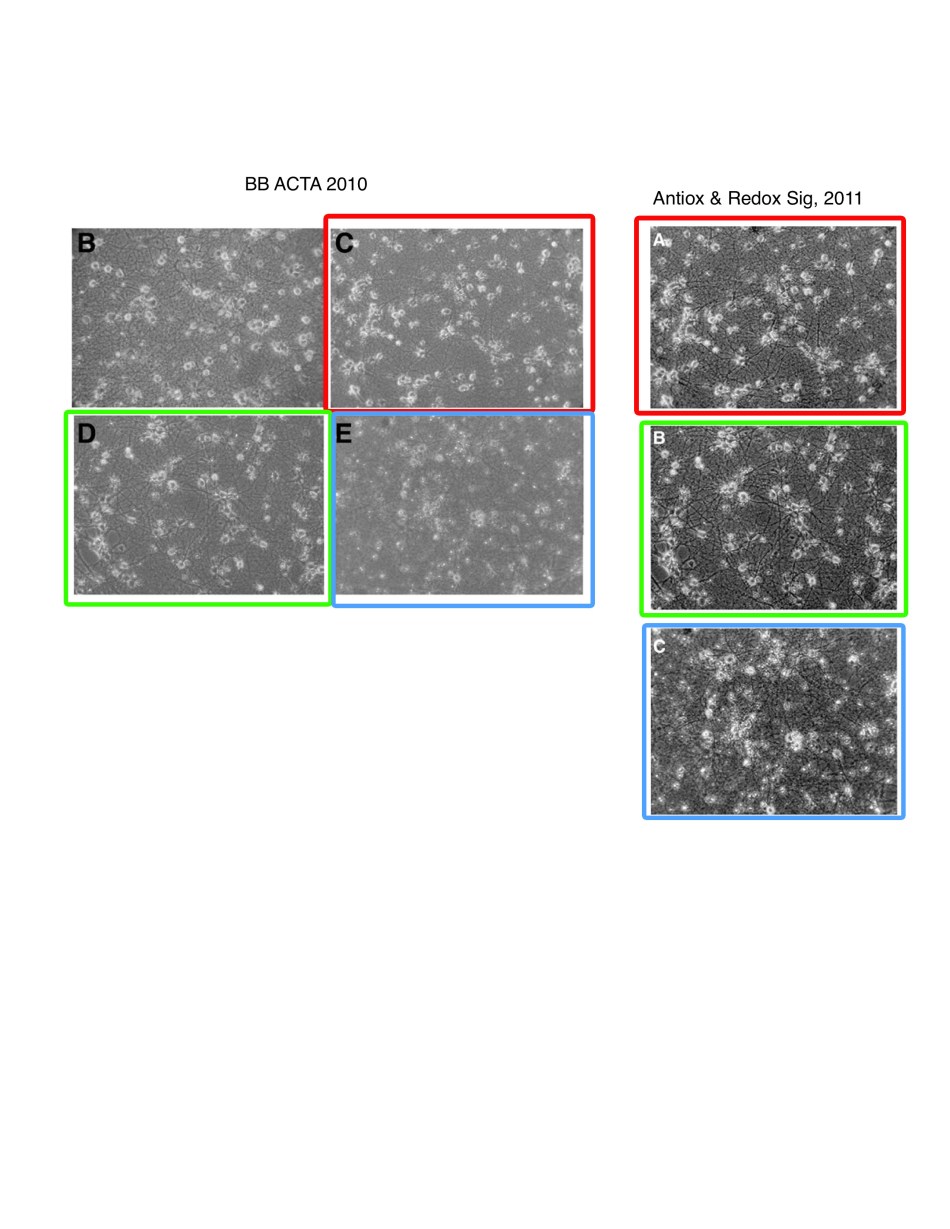

Donate!
If you are interested to support my work, you can leave here a small tip of $5. Or several of small tips, just increase the amount as you like (2x=€10; 5x=€25). Your generous patronage of my journalism will be most appreciated!
€5.00


Journals should insist that genuine controls are always shown. If not, they should run a disclaimer with the paper that goes something like: THESE AUTHORS HAVE BEEN EXEMPT FROM NORMAL STANDARDS BECAUSE THEY ARE GENIUSES AND WE ARE DESPERATE TO RUSH THEIR ONE-OFF DATA INTO PRINT.
They should also insist that all probing, stripping, reprobing sequences are described in the figure legends and results (i.e. not hidden in obscure generic statements in the methods somewhere). Ditto for exact antibodies used and concentrations thereof. Exceptions: run disclaimer above.
Papers without disclaimers should be fair game for the “loading control police.” And when caught, the penalty should be immediate retraction.
There is of course no defense for collage blots like that travesty in the infamous “Homing T-cell” Nature paper.
LikeLike
The main problem is that science worldwide has been managed like a showbiz where the “stars” instead of Marylin Monroe or Clark Gable are some politically well linked scientists who instead of being false blondes do false WBs who instead of singing “happy birthday mr President ” they are condecorated by governments for their outstanding false WBs
LikeLike
It’s absurd to label someone an abusive misogynist for asking perfectly reasonable scientific questions on their publication record. Do her supporters think she should be above scrutiny? Did she attempt to rein in the Twitter mob at all?
LikeLike
Completely agree with Stuart. It is in itself a strong indicator of guilt if a person accused of scientific misconduct as their first action attack the accuser or starts talking about something else instead of the MATTER AT HAND the data integrity issues and what could explain them.
Such a ‘create another fire’ strategy is classic of psychopaths or criminals and it stinks when a scientists behaves like this.
A good clean scientist would always reply by investigation/data/explanation on scientific grounds, nothing else.
LikeLike
Of course one might just run the gel with the standards on one of the sides…
Libraries of controls. One might as well just sign up for lifelong membership of the Museum of Creation and Earth History.
LikeLike
Pingback: The Wonderful Adventures of Nils Billestrup with Swedish gels – For Better Science
It is strange that Diabetes, which is a high impact journal, still did not reconsider the issue of the “correction”.
LikeLike
Pingback: How Andrea Cerutti molested and defiled Journal of Immunology – For Better Science
Nothing seems to move with the paper of RG & JPT. I asked Diabetes about the WBs. They investigate the case, but who knows how long it can last.
LikeLike
Pingback: New ERC President Mauro Ferrari was partner of Texas cheater Anil Sood – For Better Science
Why the Cell Death & Disease did remain silent so far? It is a long time now that the WB problem has been highlighted here. Maybe the WB of that paper (and also, the ones from the Diabetes paper of the same authors) should be used as examples of the Forensic Friday game of Retraction Watch (check it out, it is fun).
LikeLike
It was JBC, not Retraction Watch who seem to get credit for all the Research Integrity stuff others do
My favourite misappropriated RW credit was this, btw
LikeLike
Thanks for the info. It is a nice move from JBC. The last week Forensic Friday example is actually shows why it is problematic to light/contrast adjust and vertically compress WBs. https://twitter.com/jbiolchem/status/1126895032882139136
The same issue I can see in some WBs of the Diabetes paper you have mentioned in your post here.
LikeLike
“The gel bands look duplicated, after they were stretched, contrasted and put into a different experimental context. I notified the journal Cell Death and Disease about their failed correction. The academic editor Gerry Melino replied to me immediately, where he strengthened the suspicions of duplicated gel bands with his own analysis and announced to have already forwarded the case to the Ethical Committee with Springer Nature.”
https://pubpeer.com/publications/9EAE86ADF44EEB4CACC392CD08C749#2
https://pubpeer.com/publications/547032D22F8A30801B5A6BC29D88AB
https://pubpeer.com/publications/AC122FA2B5DBCAB2184F3FB7EAB7EB
https://pubpeer.com/publications/1CDDB36421B5BE5BB4D5137C1C7CDC#2
https://pubpeer.com/publications/1CDDB36421B5BE5BB4D5137C1C7CDC#3
https://pubpeer.com/publications/31307E585573221DDB2BBEF4505F8F#2
https://pubpeer.com/publications/02EE6685435E7CEC5BD6BBEBA2B7E1#3
https://pubpeer.com/publications/CE0BE1C2DA773D503CCB068935F2CF#2
https://pubpeer.com/publications/CE0BE1C2DA773D503CCB068935F2CF#4
https://pubpeer.com/publications/3A10741901F54FD8699C1C4ACB51B8#2
https://pubpeer.com/publications/600DE5CB48FE02A8B438D6623094DB#2
https://pubpeer.com/publications/D2C2775202D75FC72F3997AAEBE538
https://pubpeer.com/publications/E987C5010AAEF8EA148A009AA3C250#2
https://pubpeer.com/publications/22923A26A375AC42875C2264AC4078
https://pubpeer.com/publications/7488A57682BDE767B66F9DF941211D#2
https://pubpeer.com/publications/7488A57682BDE767B66F9DF941211D#3
https://pubpeer.com/publications/DFAA862B8CB13672CD8B7F270DE494
https://pubpeer.com/publications/74B7CCB892732E0EFE878C3FF364EC#3
https://pubpeer.com/publications/85275786B91CF866F1D03AF399E340#2
https://pubpeer.com/publications/53EDFD34CA0B4A00CC93AA083D1E41
LikeLike
Hi Zebedee, you mean the Cell Death and Disease article discussed on PubPeer here: https://pubpeer.com/publications/1C1292425188400AB6A2B0C4B6E2D0 ?
Which figure does contain duplicated bands?
LikeLike
I meant that Gerry Melino is a hypocrite of research integrity.
He is in good company.
https://forbetterscience.com/2017/11/02/oncogene-eic-justin-stebbing-a-hypocrite-of-research-integrity/
LikeLike
Pingback: Li Jia, the Research Fraud Olympian – For Better Science
These loading blot libraries are annoying. I know Jan Tuckermann from Jena, and I do not think that he was cheating with his Western blots. But I have seen him as is rather self confident person, who gets frustrated when he hears opinions other than his own. This might explain his attitude in these cases. He does not see his error. Though he is corresponding author of two papers with problematic Western blots, he insists all is fine there. The problems: loading control run on separate gels, stretching and flipping gels to represent different exepriments, increase brightness to eliminate unwanted bands.
LikeLike
Excuse me……”stretching and flipping gels to represent different exepriments, increase brightness to eliminate unwanted bands.” is FRAUD. Do not try to claim this has to do with ‘opinions’ or ‘confidence’ people who CHEAT are most often ARROGANT and overly SELF CONFIDENT.
That is because most people who “cheat” [read FRAUD, FABRICATE, MANIPULATE] are like shoplifters and other criminals….clinical socio/psychopaths.
See it all makes sense.
LikeLike
What I have heard about his lab is not suggesting intentional cheat. However, the general attitude in his lab is divisional blindness, and lack of self criticism. So what I want to say here is that the he and his lab members are probably unaware of that Western blots should be presented in a different way. And the lack of self criticism is suggested by the correction of the papers, with showing similarly problematic blots.
LikeLike
But also there is a factor which may lead to self-absorbed and self-centered attitude. In Germany only a small proportion of researchers is being ever appointed as a permanent professor, and if it happens, it usually comes when the person is already 50+. By that time the competitors die out (=no counter-opinion anymore), and the professor is encapsulated in his/her small science niche (=as a result of avoiding conflicts with competitors along years). And if the professor has been socialized in the DDR, may also think that a professor is ruler of life and death. So, maybe also thinks that if (s)he claims that a WB is correct, than the whole World should accept it, as a dogma.
LikeLike
Hi folks, if you want to prove that [a German professor] has been engaged himself in professional misconduct, better to consider his major personality traits:
He puts responsibility of his own failures on others / circumstances / undergraduate students and cleans up every evidence of his involvement of anything which has went wrong.
He blocks and bullies everybody who has pissed him off by any mean: either being a competitor of him, a student who corrected a mistake in his university lecture, a secretary/technician who did refuse unlimited extra unpaid work. So, if you made the mistake of disagreeing with him once, you have damaged his frustrated ego, so it is game over for you.
He spies on others, and uses the acquired personal information to ruin the reputation of those he wants to eliminate from his way. For example, if you ask his permission to leave early from work, since your grandpa had been taken to hospital with a diabetic coma, the next day all your colleagues will already be informed that that YOU suffer from diabetes which already started to kill your brain and that your colleagues should be prepared to take over your work at any moment. And meantime, they should keep eyes on you, and report to him directly if you show the signs of low blood sugar.
So, good luck if you want to find evidence against him.
LikeLike
Retraction notice from the lab of the German and Austrian professors because of problematic Western blots: https://www.nature.com/articles/s41419-019-1853-1?utm_source=feedburner&utm_medium=feed&utm_campaign=Feed%3A+cddis%2Frss%2Fcurrent+%28Cell+Death+and+Disease%29
LikeLike
Pingback: The return of David Latchman Show – For Better Science
Here is another explanation why loading control is unnecessary/undesired in Western blots (comment 29):
https://pubpeer.com/publications/2D084E91EDC85D6C23BC63ACF5E6A8#30
And here is another discussion on Western blots from the same group:
https://pubpeer.com/publications/7438809278C6E0BAE776D00CDF388D
LikeLike
It is not just the loading control which is the problem here. Digital editing is seen, and the method has flaws. These issues are extensively discussed on Pub Peer (just type in the search banner the name of the two corresponding authors and you see the discussions).
LikeLike
Pingback: Pier Paolo and Pier Giuseppe, the titans of IFOM-IEO – For Better Science
Cell Death and Disease has retracted the paper with manipulated WBs. However, it is NOT indicated on the PDF of the original publication that it has been RETRACTED. Only a small note has been added: A Correction to this article was published on 13 August 2019
https://www.nature.com/articles/cddis2016268
LikeLike
OK, the paper has been retracted, but the image manipulation has not been admitted by the retraction note. The last sentence of the retraction note: “The authors are repeating their experiments and a new manuscript will be submitted for peer review.” This may mean that the editorial board is about publishing soon a refreshed version of the same paper. At least an editorial policy of Nature favors such solution: https://www.nature.com/articles/d41586-019-01676-8. “Retracting a manuscript can be an opportunity to revisit the topic afresh. ” Let´s see if the Authors can convince the editorial board that it can be an inadvertent accident to stretch and flip-flop a Western blot. Besides, the pdf of the paper is not stamped with the “retracted” text, and the retraction note is linked to the main text as “correction” https://www.nature.com/articles/cddis2016268, which is not fair in my opinion.
LikeLike